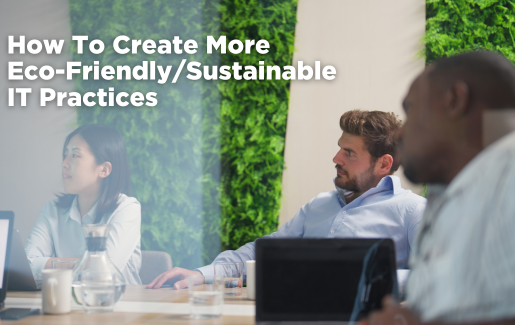 In recent years, growing concerns surrounding sustainability and our impact on the environment are becoming more and more pressing. World leaders and industries are all considering how they can reduce their carbon footprint and embrace more sustainable practices. The UN has declared that we need to reduce emissions by 45% by 2030 with goals of net zero by 2050 if we hope to wrangle the problem of global warming. One area where we have the potential to make a huge difference is with technology practices.
In recent years, growing concerns surrounding sustainability and our impact on the environment are becoming more and more pressing. World leaders and industries are all considering how they can reduce their carbon footprint and embrace more sustainable practices. The UN has declared that we need to reduce emissions by 45% by 2030 with goals of net zero by 2050 if we hope to wrangle the problem of global warming. One area where we have the potential to make a huge difference is with technology practices.
Understanding IT's Carbon Footprint
IT has helped to make great strides in certain areas when it comes to sustainability—reducing paper consumption and waste, enabling the use of smart homes to better manage energy consumption and allowing for improved environmental monitoring. But technology still exerts a cost on the environment. It can be a bit more difficult to quantify, but all of our digital activities are taking a toll as well. McKinsey reports that enterprise IT accounts for 350-400 megatons of carbon emissions.
Here are some ways technology can be harmful to our environment:
- Hardware waste: Only one in ten organizations recycle more than 10% of their hardware, creating huge amounts of electronic waste.
- Hardware management: Data centers and IT hardware require a huge amount of energy to keep running and cool, accounting for 2% of global emissions and .5% of total U.S. emissions.
- Irresponsible sourcing: Responsible sourcing is now becoming imperative for businesses. “By 2026, 75% of organizations will increase business with IT vendors that have demonstrable sustainability goals and timelines and will seek to replace vendors that do not,” reports Gartner.
- Redundant and irrelevant data: Recent estimates show that approximately 328 million terabytes of data are being created every day. Companies often try to store all of it which increases the burden on data centers and hardware.
Creating More Sustainable IT Practices
Becoming a more sustainable IT team will require internal evaluation of your existing practices and a strategic approach to improvement that involves everything from procurement to the everyday tasks of IT pros. These are the things you need to evaluate and change if you hope to embrace sustainable IT.
Sourcing Efficient Hardware
As mentioned, data centers and hardware are huge consumers of energy. Work with procurement to ensure they are evaluating the energy efficiency of any new IT equipment. Hardware providers can provide details regarding the efficiency and carbon impact of their equipment. It’s also important to consider the practices of technology manufacturers and ensure they are taking measures to reduce their carbon footprint.
Choosing Green Partners
These days, most companies engage with MSPs, vendors and other technology partners to implement and maintain their entire technology stack. When evaluating your own carbon footprint, you have to account for the sustainability practices of all partners. Start a conversation with your customers about their carbon footprint and start laying out a strategy.
Opting for Long-Lasting End User Devices
It should come as no surprise that end user devices have one of the highest carbon footprints in technology. The manufacturing process used to create smartphones and laptops is emission intensive. They have short lives and are upgraded every couple of years, then disposed of improperly. Additionally, huge amounts of data are being created through the usage of multiple individual end-user devices. We can significantly lessen our environmental impact by opting for more long-lasting and recyclable devices.
Selecting Renewable Forms of Energy
Companies can make huge improvements by investing in renewable forms of energy to power their technology. Options such as solar, hydro, biomass, wind and geothermal energy can help to power IT without negatively impacting the environment. Where possible, eliminate unnecessary energy usage or use smart spaces to monitor and adjust your usage of energy more efficiently.
Embracing Good Data Governance Strategies
You might be asking how managing data, a virtual element, can impact the environment. Businesses often take measures to stockpile every bit of data that is generated in the case that it ever becomes relevant. How well did that email campaign from five years ago perform? How many users did you have ten years ago? These metrics are no longer useful to your business. By adopting good data governance strategies, you can eliminate unnecessary data and reduce the strain on your data storage equipment and computing resources.
Disposing of Hardware in an Eco-Friendly Manner
Electronic waste is a huge factor contributing to our environmental impact. Many components are not recycled and become part of the ever-growing pile of refuse. Electronic components are not biodegradable and toxic materials can leach into the soil and contaminate surrounding areas. These conditions can lead to potentially dangerous health conditions for humans. In addition, valuable raw materials are not being extracted, leading to persistent, harmful efforts to procure even more of the valuable minerals and metals used in electronic production.
The best road to more sustainable IT practices involves a strategic plan that accounts for input from IT leaders and business stakeholders. With more efficient practices, IT can become more sustainable and help contribute to global net zero goals.
Connect with industry peers and participate in conversations about the technology topics that matter most. Learn more about CompTIA Communities.

 Add CompTIA to your favorite RSS reader
Add CompTIA to your favorite RSS reader

